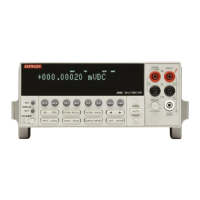Calibration
2-10
Procedure
Step 1: Prepare the Model 2002 for calibration
1. Connect the Model 2002 to the IEEE-488 bus of the
computer using a shielded IEEE-488 cable such as the
Keithley Model 7007.
2. Turn on the power, and allow the Model 2002 to warm
up for at least four hours before performing calibration.
3. Unlock calibration by briefly pressing in on the recessed
front panel CAL switch, and verify that the following
message is displayed:
CALIBRATION UNLOCKED
Calibration can now be performed
NOTE
You can query the instrument for the state
of the comprehensive CAL switch by us-
ing the following query:
:CAL:PROT:SWIT?
A returned value of 0 indicates that cali-
bration is locked, while a returned value of
1 shows that calibration is unlocked.
4. Make sure the primary address of the Model 2002 is the
same as the address specified in the program you will be
using to send commands.
5. Send the following command over the bus to initiate
calibration:
:CAL:PROT:INIT
Step 2: DC zero calibration
1. Connect the Model 8610 low-thermal short to the instru-
ment INPUT and SENSE terminals, as shown in Figure
2-1. Wait at least three minutes before proceeding to al-
low for thermal equilibrium.
NOTE
Be sure to properly connect HI, LO, and
SENSE terminals. Keep drafts away from
low-thermal connections to avoid thermal
drift, which could affect calibration
accuracy.
2. Send the following command over the bus:
:CAL:PROT:DC:ZERO
3. Wait until the Model 2002 finishes this calibration step
before proceeding. (You can use the *OPC or *OPC?
commands to determine when calibration steps end, as
discussed in paragraph 3.6 in Section 3.)
Step 3: DC Volts Calibration
1. Disconnect the low-thermal short, and connect the DC
calibrator to the INPUT jacks, as shown in Figure 2-2.
NOTE
Although 4-wire connections are shown,
the sense leads are connected and discon-
nected at various points in the procedure
by turning calibrator external sense on or
off as appropriate. If your calibrator does
not have provisions for turning external
sense on and off, disconnect the sense
leads when external sensing is to be turned
off, and connect the sense leads when
external sensing is to be turned on.
2. Set the DC calibrator output to +2.00000V, and turn
external sense off. Wait at least three minutes for ther-
mal equilibrium.
3. Send the following command to the Model 2002 over
the IEEE-488 bus:
:CAL:PROT:DC:V2 2
(Be sure to use the exact calibration value as the command
parameter if you are using a voltage other than 2V. The
allowable range from is 0.95V to 2.05V.)
NOTE
For best results, use the calibration values
given in this procedure whenever possible.
4. Wait until the Model 2002 finishes this step before going
on.
NOTE
You can check for errors after each cali-
bration step by sending the :SYST:ERR?
query to the instrument. See paragraph
2.7.2.
5. Set the DC calibrator output to +20.00000V.
6. Send the following command to the instrument:
:CAL:PROT:DC:V20 20

